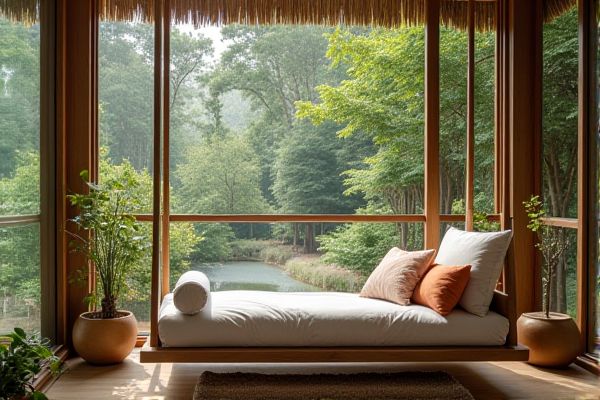
A daybed swing offers a structured, elevated seating experience with cushioning for added comfort, while a hammock provides a flexible, suspended relaxation spot that gently sways with your movement. Discover which option best suits Your outdoor space and lifestyle by reading the rest of the article.
Table of Comparison
| Feature | Daybed Swing | Hammock |
|---|---|---|
| Design | Flat, cushioned platform with swing frame | Suspended fabric or netting between two points |
| Comfort | Padded surface suitable for sitting and lying | Conforms to body for relaxed reclining |
| Capacity | Usually seats 2+ adults | Typically supports 1-2 adults |
| Installation | Requires sturdy frame or ceiling mount | Needs two strong anchor points (trees or posts) |
| Portability | Less portable, fixed structure | Lightweight and portable |
| Ideal Use | Porches, patios, balconies | Outdoor camping, gardens, backyards |
| Price Range | $$$ - Higher price due to structure and materials | $ - Generally more affordable |
Introduction to Daybed Swings and Hammocks
Daybed swings offer a blend of comfort and style with a sturdy frame and cushioned seating, making them ideal for relaxing in outdoor spaces. Hammocks provide a lightweight, portable option designed for gentle swinging and cradling, often made from breathable fabric or woven rope. Both daybed swings and hammocks enhance outdoor lounging but differ in structure, comfort, and installation requirements.
Design and Aesthetic Appeal
Daybed swings feature a structured frame with cushioned seating, offering a blend of comfort and elegance that complements modern or classic outdoor spaces. Hammocks emphasize a relaxed, minimalist design with woven fabric or rope, creating a casual, bohemian vibe perfect for laid-back environments. The choice between a daybed swing and a hammock depends on the desired aesthetic--structured sophistication versus airy simplicity.
Comfort and Ergonomics Comparison
Daybed swings offer structured support with cushioned seating and backrests, promoting proper posture and reducing strain during extended use, ideal for ergonomic comfort. Hammocks conform to the body's shape, providing a cradling sensation that relieves pressure points but may lack firm support for the back and neck. Choosing between the two depends on preference for either stable, supportive comfort or gentle, flexible relaxation.
Installation Requirements and Space Considerations
Daybed swings require sturdy support structures such as strong beams or reinforced frames for safe installation, often needing precise mounting points to accommodate their weight and size. Hammocks typically demand less structural support, with installation options including trees, posts, or dedicated stands, making them more flexible for smaller or irregular outdoor spaces. Space considerations favor hammock setups in compact areas due to their minimal footprint, while daybed swings need ample clearance for full swinging motion and comfortable seating.
Durability and Material Options
Daybed swings often feature sturdy frames made from weather-resistant materials such as teak, steel, or aluminum, providing enhanced durability for long-term outdoor use. Hammocks typically use high-quality, breathable fabrics like polyester or cotton blends that offer comfort but may require more frequent replacement due to wear and exposure. Choosing between a daybed swing and a hammock depends on desired longevity and material resilience against sun, rain, and environmental factors.
Versatility and Functionality
Daybed swings offer enhanced versatility with their structured frame, providing comfortable seating and lounging options suitable for both indoor and outdoor spaces. Hammocks excel in functionality by delivering a lightweight, portable relaxation solution ideal for spontaneous use and easy storage. Choosing between the two depends on your preference for either a stable, multi-use piece or a flexible, space-saving design.
Indoor vs Outdoor Usability
Daybed swings offer versatile indoor and outdoor usability with sturdy frames and comfortable cushions designed to enhance living rooms, patios, or sunrooms, while hammocks excel predominantly in outdoor settings, providing a lightweight, portable option ideal for gardens, beaches, or camping. Indoor daybed swings often feature space-efficient designs and plush upholstery suitable for extended lounging, whereas hammocks require ample support structures like trees or custom stands, limiting their placement indoors. Outdoor daybed swings combine weather-resistant materials and robust construction for durability against elements, contrasting with hammocks that prioritize breathability and quick-drying fabrics for outdoor relaxation and ease of storage.
Maintenance and Care
Daybed swings require regular cleaning to prevent fabric fading and cushion wear, often needing gentle washing and protective covers during inclement weather. Hammocks typically demand less maintenance, with materials like nylon or cotton requiring occasional spot cleaning and storage during rain or snow to avoid mold and mildew. Both benefit from proper storage and use of weather-resistant materials to extend durability and maintain comfort.
Price Point and Value
Daybed swings generally come with a higher price point due to their sturdy frames and versatile design, offering durable seating that can accommodate multiple people. Hammocks are often more affordable, providing a cost-effective way to relax, but may not offer the same level of support or longevity as a daybed swing. Your choice depends on whether you prioritize long-term value and comfort or a budget-friendly option for casual use.
Choosing the Right Option for Your Lifestyle
Daybed swings offer structured seating with cushioning, making them ideal for socializing or relaxing in a posture-friendly setting. Hammocks provide a lightweight, flexible option perfect for leisure and quick naps, fitting well with an active or minimalist lifestyle. Consider your space and how you plan to use your outdoor furniture to find the best match for your daily routine and comfort needs.
 homyna.com
homyna.com